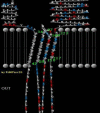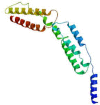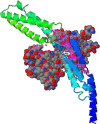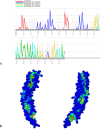In silico Homology Modeling and Epitope Prediction of NadA as a Potential Vaccine Candidate in Neisseria meningitidis
- PMID: 30234073
- PMCID: PMC6134420
- DOI: 10.22088/IJMCM.BUMS.7.1.53
In silico Homology Modeling and Epitope Prediction of NadA as a Potential Vaccine Candidate in Neisseria meningitidis
Abstract
Neisseria meningitidis is a facultative pathogen bacterium which is well founded with a number of adhesion molecules to facilitate its colonization in human nasopharynx track. Neisseria meningitidis is a major cause of mortality from severe meningococcal disease and septicemia. Neisseria meningitidis adhesion, NadA, is a trimeric autotransporter adhesion molecule which is involved in cell adhesion, invasion, and antibody induction. It is identified in approximately 50% of N. meningitidis isolates, and is established as a vaccine candidate due to its antigenic effects. In the present study, we exploited bioinformatics tools to better understand and determine the 3D structure of NadA and its functional residues to select B cell epitopes, and provide information for elucidating the biological function and vaccine efficacy of NadA. Therefore, this study provided essential data to close gaps existing in biological areas. The most appropriate model of NadA was designed by SWISS MODEL software and important residues were determined using the subsequent epitope mapping procedures. Locations of important linear and conformational epitopes were determined and conserved residues were identified to broaden our knowledge of efficient vaccine design to reduce meningococcal infectioun in population. These data now provide a theme to design more broadly cross-protective antigens.
Keywords: 3D structure; NadA; Neisseria meningitidis; epitope prediction.
Figures











Similar articles
-
Structure of the meningococcal vaccine antigen NadA and epitope mapping of a bactericidal antibody.Proc Natl Acad Sci U S A. 2014 Dec 2;111(48):17128-33. doi: 10.1073/pnas.1419686111. Epub 2014 Nov 17. Proc Natl Acad Sci U S A. 2014. PMID: 25404323 Free PMC article.
-
Mapping of the Neisseria meningitidis NadA cell-binding site: relevance of predicted {alpha}-helices in the NH2-terminal and dimeric coiled-coil regions.J Bacteriol. 2011 Jan;193(1):107-15. doi: 10.1128/JB.00430-10. Epub 2010 Oct 22. J Bacteriol. 2011. PMID: 20971901 Free PMC article.
-
Exploiting chimeric human antibodies to characterize a protective epitope of Neisseria adhesin A, one of the Bexsero vaccine components.FASEB J. 2016 Jan;30(1):93-101. doi: 10.1096/fj.15-273813. Epub 2015 Aug 24. FASEB J. 2016. PMID: 26304221
-
Genetic shifts of Neisseria meningitidis serogroup B antigens and the quest for a broadly cross-protective vaccine.Expert Rev Vaccines. 2010 Oct;9(10):1203-17. doi: 10.1586/erv.10.116. Expert Rev Vaccines. 2010. PMID: 20923270 Review.
-
Neisseria meningitidis, pathogenetic mechanisms to overcome the human immune defences.J Prev Med Hyg. 2012 Jun;53(2):50-5. J Prev Med Hyg. 2012. PMID: 23240160 Review.
Cited by
-
Single Domain Antibodies Targeting Receptor Binding Pockets of NadA Restrain Adhesion of Neisseria meningitidis to Human Brain Microvascular Endothelial Cells.Front Mol Biosci. 2020 Dec 23;7:573281. doi: 10.3389/fmolb.2020.573281. eCollection 2020. Front Mol Biosci. 2020. PMID: 33425985 Free PMC article.
-
VARIDT 2.0: structural variability of drug transporter.Nucleic Acids Res. 2022 Jan 7;50(D1):D1417-D1431. doi: 10.1093/nar/gkab1013. Nucleic Acids Res. 2022. PMID: 34747471 Free PMC article.
-
Design of a new multi-epitope peptide vaccine for non-small cell Lung cancer via vaccinology methods: an in silico study.Mol Biol Res Commun. 2022 Mar;11(1):55-66. doi: 10.22099/mbrc.2022.42468.1697. Mol Biol Res Commun. 2022. PMID: 35463817 Free PMC article.
-
Expression, epitope prediction and IgE-binding of the Tyrophagus putrescentiae group 13 allergen.Exp Ther Med. 2020 Nov;20(5):21. doi: 10.3892/etm.2020.9149. Epub 2020 Aug 27. Exp Ther Med. 2020. PMID: 32934686 Free PMC article.
-
In silico Structural, Functional and Phylogenetic Analyses of cellulase from Ruminococcus albus.J Genet Eng Biotechnol. 2021 Apr 19;19(1):58. doi: 10.1186/s43141-021-00162-x. J Genet Eng Biotechnol. 2021. PMID: 33871739 Free PMC article.
References
-
- Yazdankhah SP, Caugant DA. Neisseria meningitidis: an overview of the carriage state. J Med Microbiol. 2004;53:821–32. - PubMed
LinkOut - more resources
Full Text Sources
